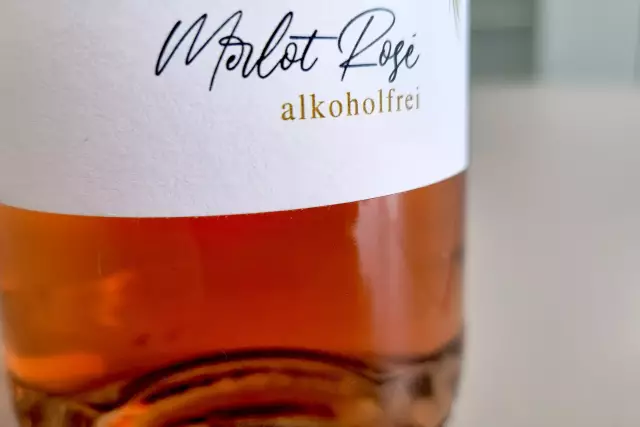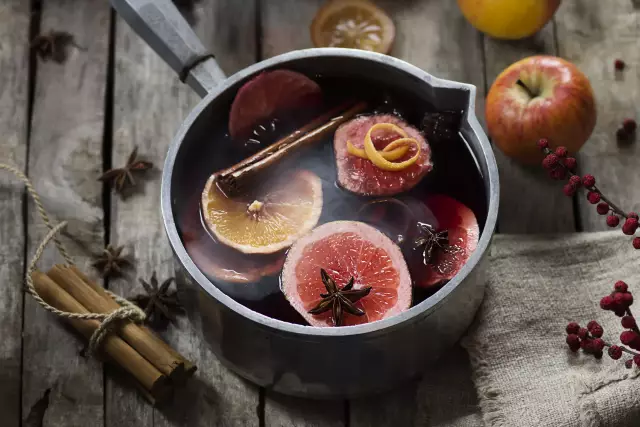Punch
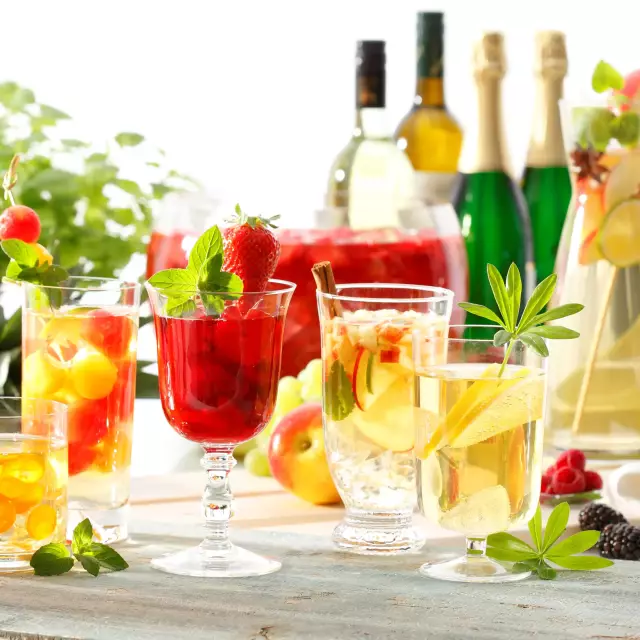
Punch is a refreshing summer drink made of wine, sparkling wine and fruit or herbs. Colourful, fruity and well chilled, this fizzy classic guarantees fruity enjoyment.
Facts
-
3-5
ingredients
-
18.
century
-
50s
years
There’s really not much you can do wrong with this fruity cocktail – if you keep a few simple basic rules in mind:
- The best punches only use a couple of ingredients.
- A punch is only ever as good as the wine or sparkling wine used in its making. German quality wine, a light Kabinett and fruity Winzersekt are excellent choices.
- Only use fresh and fully ripe fruit.
- Peel and chop the fruit carefully – do not crush it.
- To get the fruit to develop its full aroma, just sugar it lightly or marinate it in grape liqueur. If you prefer a sweet punch, use sweet wines.
- Only add – well chilled – sparkling wine and mineral water just before you serve the punch. This way, you’ll keep it fizzing for that much longer.
- The ideal serving temperature for a punch is 5-8 °C, slightly cooler than for wine.
Do not add ice cubes to the punch. This will water it down. Best place the punch bowl inside a larger bowl filled with crushed ice.
And another thing: Once the punch is dwindling, do not top it up. It’s better to serve a good wine after the punch is finished.
Strawberry punch
Prepare a large plate full of fresh strawberries. Cut larger strawberries in half or quarter them. Sprinkle with sugar and let them sit for a while to release their juice. Alternatively, marinate the fruit in grape liqueur. Next, place fruit and juice in a punch bowl and let them steep in a little wine. Later, add 4-5 bottles of wine, such as well chilled rosé or Weißherbst. If possible, place the punch bowl on crushed ice. Just before serving, add a bottle of German Winzersekt and enjoy.
Peach punch
Peel 6-8 ripe peaches, cut them in half and remove the stones. Sprinkle the fruit pieces with sugar and let them steep. Next, add 3-4 bottles of wine, such as Riesling or Silvaner, and let the mixture steep for a couple of hours, preferably on ice. Just before serving, add a bottle of German Winzersekt for that zesty finishing touch.
Kumquat punch
Wash 15 kumquats in hot water, dry them and cut them into thin slices. Sprinkle with brown sugar and add a little wine, such as Pinot Gris or a mature Riesling. Let the mixture steep for a couple of hours, then top up with 2 bottles of wine and leave it to steep for some more time on ice. Just before serving, add a bottle of Winzersekt for that delightful sparkle.
How punch got its name
The German term for the refreshing summer cocktail made of wine and fruit is Bowle, derived from the English word “bowl”. Allegedly, the cocktail was invented by British colonial officers in India. To invigorate themselves and to overcome the sheer boredom of Colonial life, they got their Indian servants to create drinks for them that used at least five – or “punch” in Hindi – ingredients. Those were then served to the officers in a large “punchbowl”.
Thus the British started the fashion for punches in Europe in the 18th century. Initially reserved to nobility, drinking punch soon became a favourite pastime in bourgeois circles as well. The favourite drink of the 19th century high society later became the party craze of the 1950s. Today, the cocktail is becoming fashionable once again as an invigorating, fresh and fruity drink for the summer.
Do you know any other kind of punch than the traditional punch?
Besides the traditional punch like Cold Whisky Punch, Roman Punch, Ginger Punch,... for which spirits like brandy and whisky are used, you can also use grape wines to make a punch. How to make it? Find out in this article!
Varietals

More recipe ideas
with semi-dry wines Flädlesuppe
with semi-dry wines
- 1 Bund Schnittlauch
- 1 Liter Fleischbrühe
- 150 Gramm Weizenmehl
- 300 ml Milch
- nach Belieben Speckschwarte zum ausreiben der Pflanne
- Etwas Salz
Make a smooth, not too thick batter from the flour, milk, eggs and a pinch of salt. Heat a heavy frying pan on a high heat, rub with bacon fat, pour in a small dollop of batter, allow to spread and fry thin pancakes (flädle).
<p
<p>Leave the pancakes to cool, halve and cut into thin strips.
Place in clear, very hot meat stock and serve immediately.
<p- Trollinger (halbtrocken & feinherb)
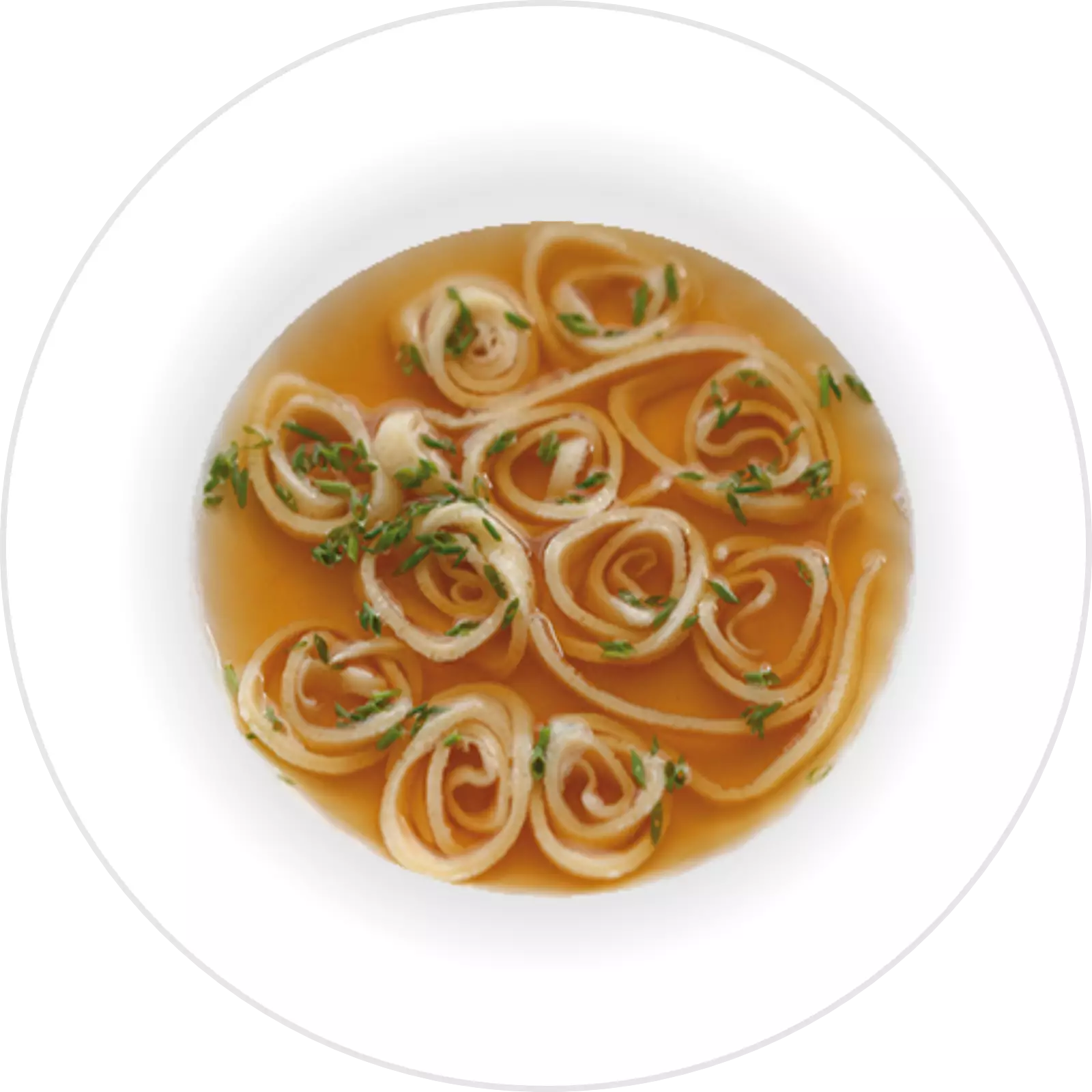
with honey and thyme Goat's cheese tower
with honey and thyme
- 1 großer Apfel
- 1 Rolle Ziegenkäse
- 4 Scheiben Bacon
- 4 TL Honig
- 1 TL Thymian
- 4 Blätter Eichblattsalat
- frische Zweige Thymian zum Garnieren
- nach Belieben Salz & Pfeffer
Preheat the grill to the highest setting.
Fry the bacon slices without fat in a non-stick frying pan until crispy and drain on a piece of kitchen paper. Leave the rendered fat in the pan.
Wash the apple, core it with a corer and then cut it into four, approx. 1 cm thick slices. Slowly fry the apple slices in the remaining bacon fat until just cooked, using the tip of a knife to check the doneness. Place the apple slices in a lightly greased baking dish, sprinkle with thyme and place a crispy fried bacon slice on top of each one.
Divide the goat's cheese into 4 thalers and place one thaler on each apple slice, sprinkle with thyme again and drizzle with 1 teaspoon of honey.
Bake under the grill until the cheese is lightly browned.
Serve the goat's cheese and apple tartlets on a lettuce leaf or, if you prefer, on a bed of lettuce (add a honey-flavoured dressing)
- Dornfelder (halbtrocken & feinherb)
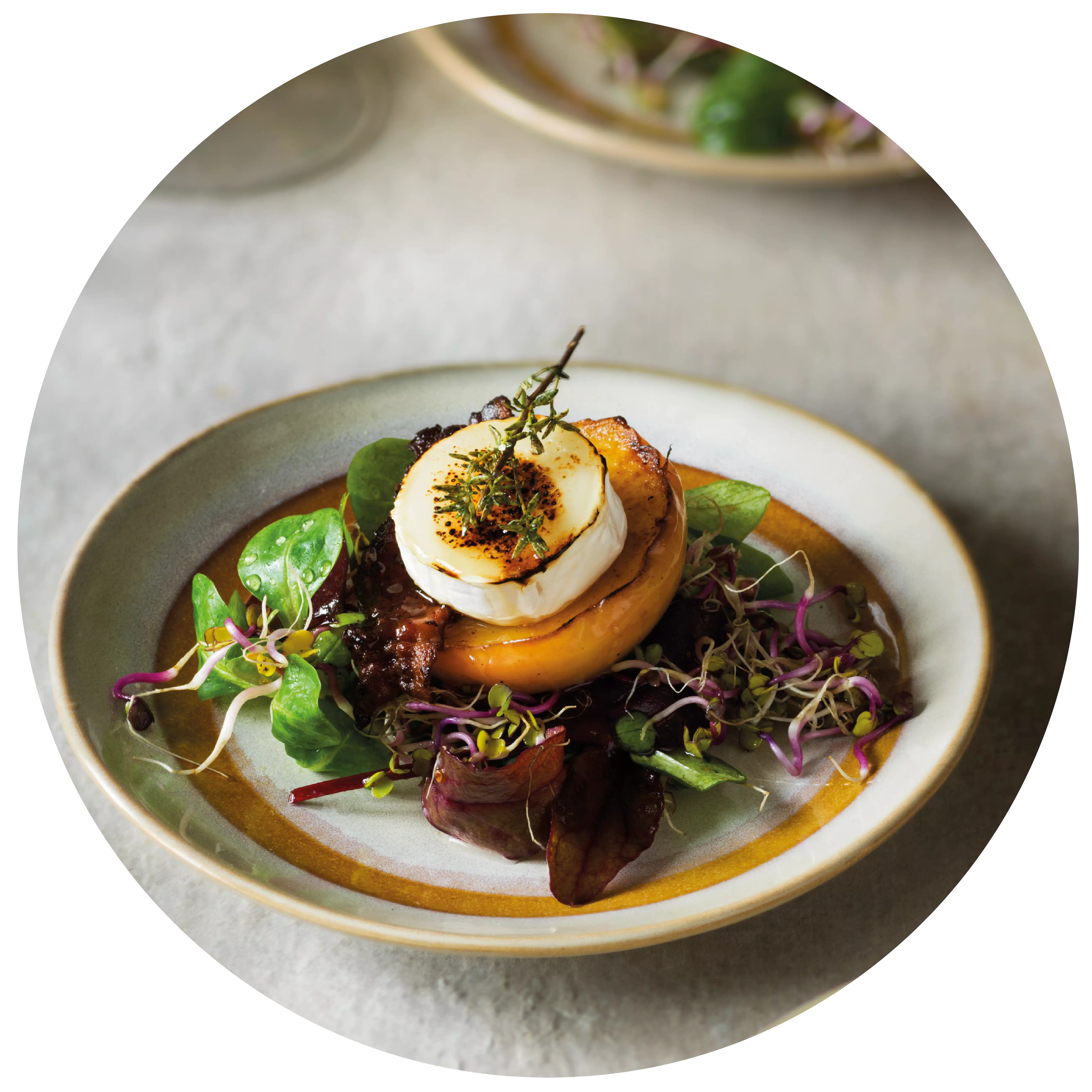
with wild duck breast, porcini mushrooms and glazed chestnuts Herb salad
with wild duck breast, porcini mushrooms and glazed chestnuts
- 150 Gramm Wildkräuter
- 4 EL Olivenöl
- 2 EL Balsamessig
- 8 Stück Wildentenbrüste (a 100g)
- 2 EL Sonnenblumenöl
- 4 EL Honig
- 1 EL Thymian
- 200 Gramm Steinpilze
- 20 gekochte Maronen
- 100 ml Apfelsaft
- 2 El Zucker
- nach Belieben Salz & Pfeffer
Clean, wash and pat dry the wild herbs. Marinate with olive oil and balsamic vinegar and season with salt and pepper.
Preheat the oven to 220°C top and bottom heat. Season the wild duck breasts with salt and pepper, sear on the meat side in a pan with sunflower oil and cook in the preheated oven for about 8 minutes on the skin side. Remove the duck breast, brush the skin side with honey and thyme and roast for another 2 minutes on a high heat until crispy.
Clean the porcini mushrooms and cut into slices. Fry in a pan in oil on both sides, remove and keep warm. Caramelise the sugar in the pan, deglaze with the apple juice and simmer until the caramel has dissolved. Add the chestnuts and add a little more apple juice if necessary.
- Pinot Blanc (trocken)
- Gutedel (trocken)
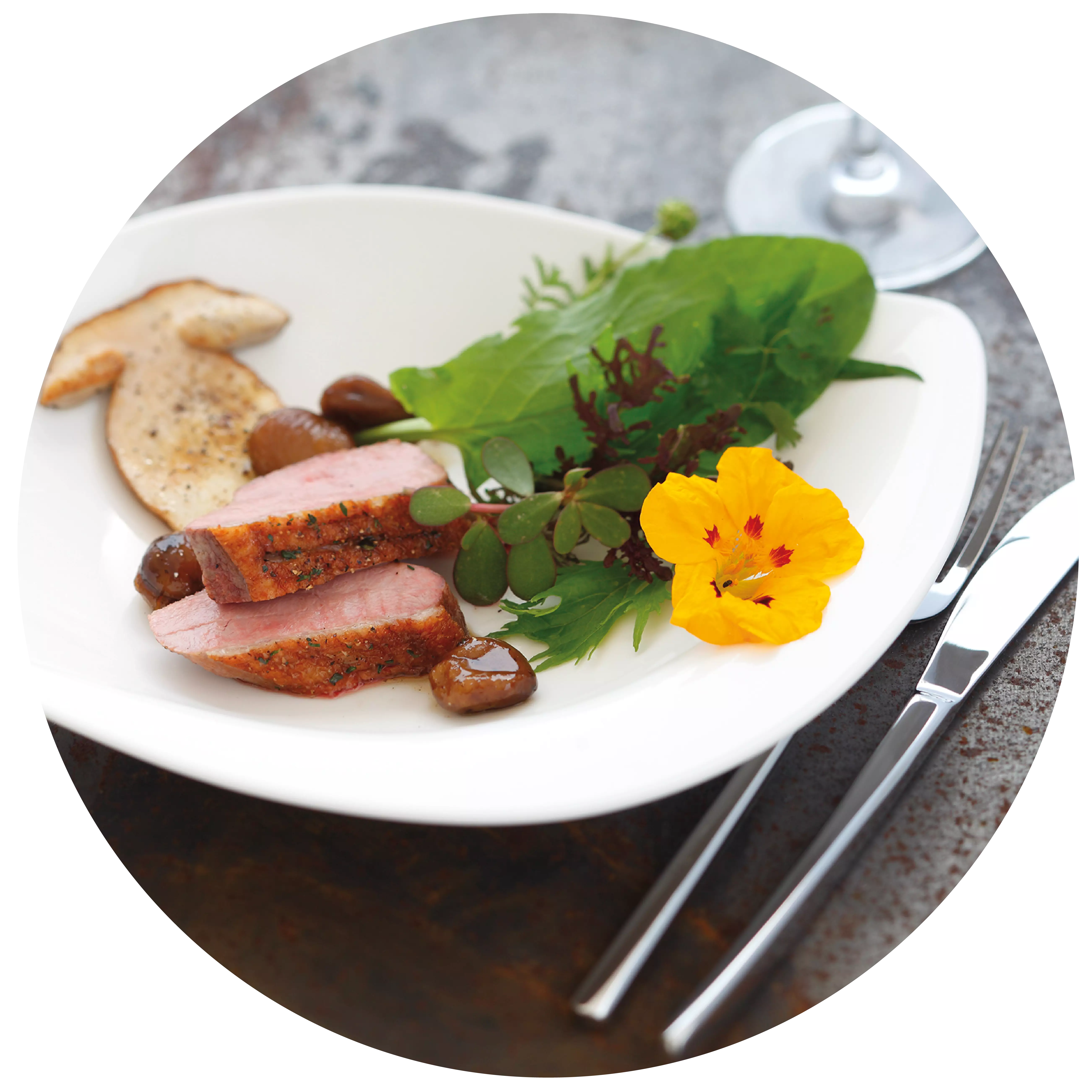
with ribbon noodles Coq au Riesling
with ribbon noodles
- 1 ganzes Huhn
- 0,4 Liter Riesling
- 0,2 Liter Sahne
- 1 kl. Glas Cognac
- 2 Stück Schalotten
- 1 Stück Knoblauchzehe
- 1 Stück Eigelb
- 1/2 Bund Petersilie
- 1 EL Mehl
- 50 Gramm Butter
- 1 EL Olivenöl
- nach Belieben Salz & Pfeffer
Carve the chicken. Heat approx. 50 g butter with 2 tbsp olive oil in a large frying pan and fry the chicken pieces until light brown (without the lid). Season lightly with salt.
Finely chop the shallots, peel and finely chop the garlic. Chop the parsley and add everything to the meat. Sauté briefly with the pan closed. Pour the cognac over the meat and light it (flambé). Deglaze with 1/3 litre of Riesling and leave to simmer for half an hour over a low heat. If necessary, add a little more wine and simmer for a further 10 minutes.
Remove the chicken pieces and keep warm for a short time. Mix 1 tbsp of flour with 1 egg yolk and the cream and whisk into the sauce. Flavour with salt and pepper. Return the chicken pieces to the pan. Serve immediately.
This goes well with tagliatelle.
Variant:Fry 150 g fresh mushrooms in 50 g butter and add.
- Riesling (trocken)
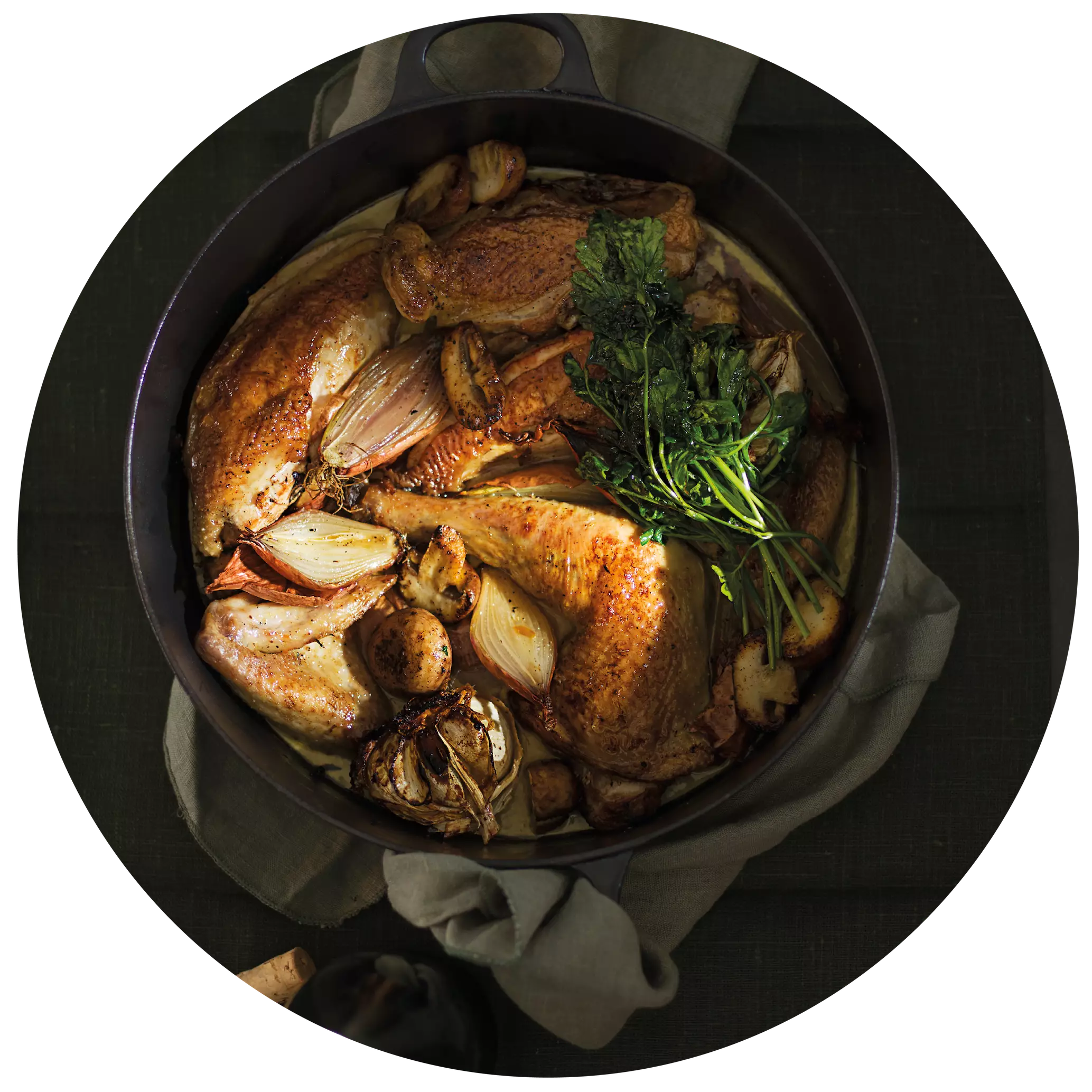
Events
-
Show
winetasting in our winery - blind tasting
Mainz-Hechtsheim


